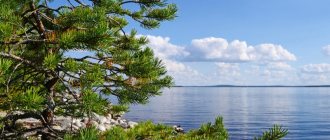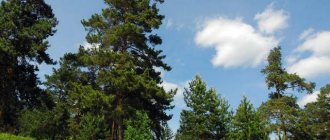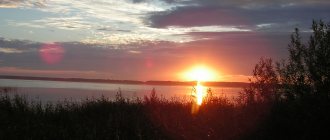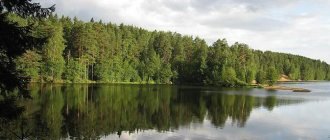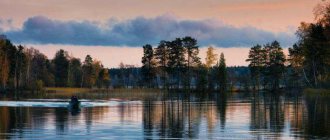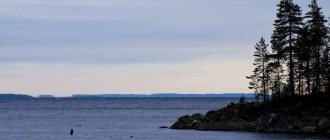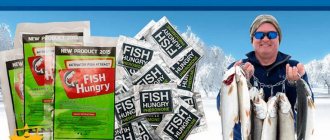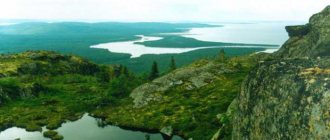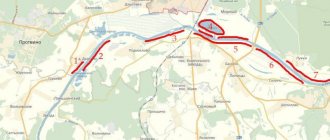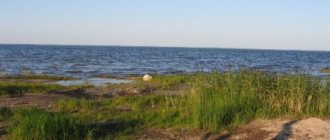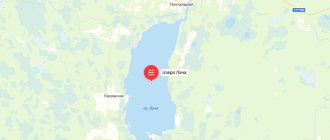Topozero is the fourth largest lake in Karelia and the thirteenth in Russia. The area of the reservoir is huge and amounts to almost a thousand square kilometers.
28 tributaries flow into Topozero, including eight large rivers. And only one comes out - Kovda. It connects the reservoir with the White Sea.
The shores of the lake are uneven, indented by endless bays and picturesque bays. There are also many islands on the reservoir - 144 in total. There are also quite large ones, so the reservoir provides excellent opportunities for those who want to feel like a real Robinson. It’s just problematic to meet Friday here - the long shores of the lake are very sparsely populated.
© IgorK
Fishing on Topozero
Topozero is home to 16 species of fish. Favorite catches include lake trout, vendace, whitefish, grayling, roach, ide, burbot and perch.
The vegetation on the reservoir is poorly developed. Horsetail, sedge and reed are concentrated mainly in the southeastern part of the reservoir. Therefore, fish that prefer habitats overgrown with aquatic plants should be looked for there.
Winter fishing is no less popular than summer fishing. Due to its impressive size, Topozero freezes unevenly. In the southern part the ice appears by the end of November, and in the northern part it often appears a month earlier.
© SirTirexEndMore
Topozero – fishing in Karelia
Topozero amazes with the extraordinary beauty of the magnificent nature of the North and the wealth of fish stocks.
This delightful Karelian lake leaves the most indelible impressions and a desire to visit these fabulously beautiful lands again. Fishing in Topozero in Karelia
will be remembered by anyone who visited here and was able to experience fishing happiness.
However, fishing in Topozero
is not as simple as it seems at first glance.
This lake is one of the extreme links in the Kovda River basin, which flows into the White Sea. The area of the lake is 1049 km². Among the lakes of Karelia, Topozero ranks 4th. This is an irregularly shaped body of water that stretches from northwest to southeast. The lake is divided into two parts - the main northern one, which has a wide reach, and also a slightly smaller part in the southeast. Which is very elongated and narrowed. The lake has a number of small and large bays, some separated from the lake. There are also many small and larger islands on the reservoir, which are mainly located in the southern part of the reservoir.
The lake has 28 tributaries, of which the largest are Valazerka and Kizreka, but their length is no more than several tens of kilometers. All other tributaries of the Topozero are small streams and rivers flowing from swamps and small lakes. The Sofyanga River flows from the northern part of Topozero and flows into Pyaozero. However, the water exchange of the lake is very slow. Water fluctuations throughout the year are no more than 40 cm. Fishing in Topozero has its own characteristics due to the fact that it is a rather deep reservoir. Its depth on average reaches 15.5 m, and the greatest depth can reach 57 m. As for the bottom topography, it is quite complex and consists of depressions (pits and depressions) and elevations of the bottom (ridges, ridges, etc.), but In some places there are areas with a fairly flat bottom.
Fishing in Topozero
quite diverse and very interesting. This reservoir is home to about 16 species of fish, including such valuable ones as palia, brown trout, grayling, whitefish, and vendace. Fishing for such types of fish as smelt, perch, pike, bream, roach, chub and burbot is also very popular.
Pale, smelt, burbot, roach, ide, perch, grayling, and pike are caught on an industrial scale.
In terms of searching for predators, this is a rather difficult reservoir, because in such wide open spaces it is not the easiest task to find predatory fish. Local fishermen assure that there are a lot of pike and grayling in the reservoir and these types of fish are caught very well. But trout are caught only by trolling, and fish such as palia have not even been caught in nets lately, so that many anglers are satisfied with catching pike and grayling. Pike and bream are excellently caught on Topozero. By the way, you should know that there are not many perch in this reservoir, but mostly humpback whales bite. The perch bites especially well at dusk, when the fish come out to the spits and feed there.
However, even though there are quite a lot of grayling in the reservoir. Grayling fishing in
Topozero
is not the easiest. After all, this fish prepares different surprises every time and presents itself in different ways. The baits used to catch grayling are very diverse, and if in the morning this fish grabs one bait, then in the evening preference is given to another bait. This species is characterized by frequent changes in behavior. And this happens quite intensively throughout the day. This fish is very unpredictable and incomprehensible. Perhaps the sharp change in the weather of the North is having an effect, and the fish is behaving accordingly.
However, one factor always remains the same - the most intense grayling bite occurs in the mornings and during sunset. At these moments there is practically no wind and you can watch how small graylings jump out of the water, hunting for insects. The best places to catch grayling are near islands where food was blown from the trees directly into the water, but only when the wind stopped. The grayling bite also stopped, and this fish ignores almost all baits.
At the same time, when the fish were actively feeding, large spoons were used, the 3=4 number of spinners worked especially well. Local fishermen assure that catching grayling is a real pleasure with such a spoon. The bait flies well and far, and also attracts fish well. And the grayling swallows even a large hook without difficulty.
The most popular spinners are the popular models Myran, Blue Fox, DAM. The color of large spinners does not play a significant role. Grayling responded much better to light-colored tones. As a rule, this only works during the feeding period of this fish.
Often fishing in Topozero for grayling
It is carried out from the shore, if it is not possible to catch it from a boat, rotating spoons No. 1-2 have proven themselves well here. But the most effective of them are DAM spinners with bells. Mostly single graylings that control their areas are caught from the shore. Typically, such a single grayling lives near numerous islands, where the depth reaches 3-4 m.
One gets the impression that a single grayling is located near its snag or its stone and does not allow anyone to approach its control zone at a fairly large distance.
However, grayling gets a good bite only on spits, and near islands, or on dumps near shoals, the depth of which reaches 2.5 -4 m. At greater depths, there are practically no grayling.
It is also promising to fish the mouths of rivers that flow into Topozero. First of all, Kizrkek and Valazrek. Fishing on these rivers is even more interesting than in the waters of Topozero itself. On these rivers there are quite good chances of catching, albeit not large, but very beautiful brook trout. In addition to trout, you can catch large roach and ide there. Upstream, Valazreka passes through a shallow small lake, where many grass pike live. Further on the river there is a jam of fallen trees and there the most interesting places begin, where there are many rapids. If you swim upstream of Kizreki, you can also reach an excellent place with a fast current and a decent rocky rapids.
Whatever you say, Karelia is the land of a fishing dream and fishing in Topozero
Karelia is a real pleasure for any fisherman.
Huts
On Topozero there are several small houses or log cabins where you can experience all the delights of truly secluded living. They are located on Cape Riviniemi, the island, Gorely Island and in other hard-to-reach places. Most huts are designed for 6–8 people.
You can only get to the houses by water - the transfer is mainly carried out from the village of Sofporog. It is important to consider that tourists are not taken to the huts in October and November due to frequent autumn storms. Also, casting is not carried out during the freeze-up period before the formation of strong ice and in the spring, when it melts.
The interior of the houses on Topozero is almost Spartan, but there is everything you need. A potbelly stove is used for heating. You can cook on a gas stove or fire. The houses have bedding and dishes.
There are bathhouses near the houses. The shore has its own beach and gazebo.
Telephone communication is usually available at a specific point indicated by the conductor. On the other shores of the lake, you won’t be able to simply make a call either—you’ll have to look for a stable signal.
© Artem Grigoriev
PHYSICAL AND GEOGRAPHICAL CHARACTERISTICS
Topozero consists of a number of separate reaches, which are connected to each other by narrow and short straits. The length of the lake is 9.1 km, the greatest width is 2.5 km, the total area is 6.8 km2, the area without islands is 6.48 km2. The length of the coastline on the mainland is 35.1 km, with islands 41 km. Height above sea level 151.7 m.
The shores of the lake are mostly steep, rocky, and covered with mixed forest. Only the western shore of the southwestern narrow reach is low and swampy in places. There are no open banks, arable lands and meadows do not approach the shore. There are about 25 islands on the lake. The most significant o. Bolshoy is located in the central part of the lake, where Fr. Wire, smaller sizes. Along the northwestern coast of the central reach, 1-1.5 km from the village of Topozero, there are many small islands and rocky areas scattered.
Topozero is a fairly deep body of water. Depths greater than 10 m account for 40.7% of the bottom area; the average depth is 10 m, the greatest is 35 m. A sharp drop in depth is characteristic. In many areas there are underwater accumulations of boulders. Often the rocky extensions of the capes are connected - by the same capes of the islands - long rocky ridges are created. Most of the bottom area is occupied by silty soils. Their upper boundary runs at depths from 2 to 5 m, and in the northern reach at a depth of 1–2 m.
The Tyupig River, flowing from Lake Tyupige, flows into the southeastern reach of the lake, and the Tuksunpiya River, originating from the swamps, flows into the southwestern narrow strait of the lake. This river is full of water in spring and autumn, and dries up in summer. 0.5 km southwest of the village of Topozero, a stream flowing into the lake flows from a small lambina located among the swamps.
The thermal regime characterizes Topozero as a cold-water reservoir. In summer, the upper layers of water do not warm up above 20°. In the central part of the main reach (35 m) and in the eastern reach (18 m), the temperature difference was 7.0°. The temperature jump in September in individual reaches of Topozero is observed at different depths: in the northern reaches and in the eastern reach it was noted at 8 m, and in the main reach at 12 m.
The color of Topozero water is light brown, transparency (at the beginning of September) did not exceed 2.4 m.
The lake becomes free of ice in mid-May and freezes at the end of November.
Topozero is a polyhumous oligotrophic reservoir.
Weather
The weather on Topozero requires caution from those vacationing on the water due to its changeability. Sharp gusty winds bring storms that can rage for several days. They are especially frequent in the fall, but can happen at any time of the year.
The main summer holiday season on Topozero is July and the first half of August. Despite the fact that the reservoir is located in the Subpolar zone, it is quite suitable for swimming in both the northern and southern parts. During the season, the water in shallow water warms up to +17 degrees. However, this period does not last long - a few weeks.
In summer there is a polar day on Topozero. Long white nights make the landscapes of the reservoir truly picturesque.
Weather forecast for Topozero (in the village of Kestenga) for 10 days - Yandex. Weather
© Artem Grigoriev
A fisherman's dream came true on Topozero
In mid-June, my friend called with an offer to go fishing in Karelia on Topozero, because... his team fell apart for various reasons, and the planned fishing on the Kola Peninsula did not take place. No sooner said than done. Moreover, he himself had a strong desire to open the fishing season on Topozero. And so on June 27 at 07.00 we rush from St. Petersburg along the Murmansk highway towards Topozero and the taiga.
The Murmanskoe highway is magnificent, except for the last section after the turn from the federal road to the village of Kestenga (56 km). In general, we made it home with all the stops like - to eat, refuel, rest, walk around - in 11 hours (at a friend’s LC-100).
The village of Kestenga greeted us with lingering light rain, perfect calm, and of course mosquitoes, which, according to local residents, appeared literally the day before our arrival. Since the rain did not want to stop, but only got worse, it was decided to spend the night in the village, and in the morning we would pack up and go to a hut in the wilderness of our native land. In the morning the sun came out, and we, delighted by this miracle of nature, cheerfully gathered and on two boats (Ob-m with Yamaha-25 and PVC 3.6 with Tohatsu-9.8) set off along Topozero, because there is no other way to the hut. It was decided to troll at 4.5-5 km/h. After 5 hours of fruitless attempts to catch something, we got away and went on our way.
We've arrived, or rather we've arrived
The hut greeted us cordially. Clean and tidy, dry and cozy, the stove has ready-made kindling - just strike a match. The washbasin is full of water. In general, everything is in place and according to fishing Feng Shui. We quickly prepared dinner and went into battle.
The water under our eastern shore of Topozero is only +3. All attempts to catch something on the first evening failed. This upset us a little, but not enough to make us feel despondent. At the council before going to bed, a strong-willed decision was made in the morning to go to the other side of Topozero, under the islands (and there are more than a hundred of them there). Looking ahead, I will say that this was the right decision. In the morning (a relative concept, because at this time of year the sun does not set in northern Karelia - it is a polar day), having a quick breakfast and taking a snack with us, we sailed to a distant destination. We were trolling, and near the first ridge of islands, in complete calm, we visually spotted a feeding grayling. Immediately, having reeled in the trolling rods, we crept up on tiptoe and began fishing with small wobblers and spinners. Grayling didn't have to wait long. While I was assembling the spinning rod, my friend, from the first cast, was already dragging quite a food-grade grayling (weighing showed 800 grams). I didn’t lag behind either - in 30 minutes. I caught two more about the same, and silence. Then both my friend and I each had one wobbler cut off by a pike. She also went out to warm herself after spawning on a stone ridge. The third, about three kilograms, was observed a meter from the boat.
Grayling - great catch
We decided to move on. We walked for another two hours. As usual, unexpectedly - the spinning rod bends, the clutch cracks. My heart started beating faster. That's all. Silence. It's a shame, annoying, but okay. Towards evening, a strong wind blew, dispersed the wave, and it was decided to leave the PVC on the nearest island (it would have sailed against such a wave four hours ago) and return to the hut on Obyashka. The dinner was royal. Fresh grayling caught with your own hands using your own gear is incomparable.
A fisherman's dream come true
The next day, naturally, I had to go there. You still need to pick up the boat. And, lo and behold! Literally in the same place where there was a bite yesterday, it bit again. There is not enough talent to describe it - it is adrenaline over the edge, a fight with an unknown beast. Time has stopped, all thoughts are only about how not to make mistakes when fishing. In general, when she surfaced about three meters away from the side and showed a fin (like a dolphin), I realized that it was a trophy. A few more minutes of struggle, and the fish is in the boat. Emotions, screams, hands trembling from overexcitation. This is the fish of my dreams. My friend also had a bite, but, like me the day before, it was missing. After spinning around for another three hours, we went home to the hut.
Oh this weather
The next day, despite the fact that it was very sad with gasoline, of course we went to a cool place, but, alas and ah, the fish categorically did not want to be caught. We decided to hunt for grayling. It was caught, but capriciously, not all of it had recovered from spawning yet. Oh the weather this year! And in Karelia too. Summer is a month late in these parts. Yes, I completely forgot, the water temperature in the area of the islands was already +10, and the distance from the hut was about 10 km.
Final day
Because We couldn't afford the gas, so the decision was made to go to the village. During the days of our stay in the hut, the nature of Karelia awakened before our eyes. The water on our shore of Topozero also warmed up to +10 on the day of departure. The grayling began to wake up. We drove back to the village of Kestenga in complete calm. We changed clothes, ate, loaded up and headed home to St. Petersburg. The way back flew by unnoticed under the impressions of fishing, discussions and guesses why it was this way and not that way. Working on mistakes and making plans for future fishing trips.
What attracts me personally to fishing is that you never know exactly where, when and for what. You have to constantly experiment, discover something new. I am pleased with this fishing - the brown trout pulled 7 kg. This is my record so far, because last year here, on Topozero, it was 5 kg. Now the bar needs to be raised to 10 kg. And in this lake there are fish up to 12 kg. There is something to strive for.
Sources:
https://www.fishing.ru/articles/view/1485/ https://fisher.spb.ru/blogs/view.php?postId=754 https://izba-topozero.ru/puteshestviya/12-rybalka -v-karelii-topozero-2017.html
The depth and shores of Topozero
The average depth of Topozero is 15 m. The maximum depth of the reservoir is 56 m. The lake has relatively shallow areas with a depth of 0 to 5 m. This is approximately a fifth of the area of the reservoir. The deepest is the spacious northern reach. An accurate map of the depths of Topozero has not yet been compiled.
Despite such impressive depth, Topozero is distinguished by its transparency. In the deep reaches, visibility is 6–8 m. In the shallower southern reaches, it can be reduced to 2–3 m. The water is not only transparent, but also clean.
The shores are mostly rocky and low. In many areas, dense coniferous forest approaches the water itself.
There are many sandy beaches, but the bottom is mostly muddy. In the overgrown, relatively shallow part, certain sections of the coast are swampy.
© moroshka58
Topozero is a very sparsely populated body of water. Most local residents live in the north in the villages of Kestenga and Sofporog, as well as in Pyaozerskoye, a little away from the reservoir. Since there is a road leading here from Petrozavodsk, most tourists also prefer the northern shore of the reservoir.
When going to Topozero, it is important to prepare for a completely independent holiday and take everything you need with you, as well as carefully monitor the weather if you plan to go out on the water. You will have to wait quite a long time for help in case of an emergency.
© venom1965
Hydrology:
The drainage area of the lake is 3570 sq. km. The lake's water exchange is very slow. Average annual fluctuations in water level are 35-40 cm, the most significant being 75 cm. The lake is dominated by wind currents, but in some areas between the islands there are also wind-independent currents.
According to its thermal regime, Topozero belongs to cold-water reservoirs. The lake usually becomes free of ice in the second half of May, less often in early June. In the bays, the temperature of the surface layers of water averages about 10° in June, 15–17° in July, 14–17° in August, 9–10° in September, 2–5° in October, 0.6° in November. 0.8°. In an open lake in summer, surface temperatures reach 16-18°. High surface temperatures are observed for a short time at the end of July or in the first half of August. At a depth of 10 m in early August the temperature was 8.6-11.6°, at 20 m - about 7°, and at depths of more than 30 m - 5-6°. By the end of August, bottom temperatures in the deep parts of the lake rise to 9° and above. The temperature jump is expected at the end of July or at the beginning of August. In mid-August, a clearly expressed temperature jump was observed at a depth of 9-10 m. From the second half of August, the surface temperature usually decreases, the temperature jump layer drops and smoothes out. The state of complete homothermy is established in September. In the southeastern part of the lake, the water column warms up more than in the northern part. The lake freezes in the second half of November, less often in early December.
The hydrochemical regime is characterized by high oxygen saturation and low mineralization of the water mass. In summer, in the northern open part of the lake the pH value is 6.65–6.75, in the southeastern part 6.45–6.55. The oxygen content is high throughout the water column and amounts to 10-11 mg/l (90% or more saturation). The content of free carbon dioxide is low in the upper and bottom layers of water. The average amount of hydrocarbonates for the entire lake is 12.6 mg/l, silicic acid—2.56 mg/l, iron—0.41 mg/l, phosphates—0.034 mg/l, oxidizability (permanganate) 4.64 mgO2/l . The organic part of the dry residue for the northern part of the lake is 65.9%, for the southeastern part - 69.5%.
Things to do
On Topozero it is absolutely not necessary to just fish. If water trophies are not of interest, there are plenty of other activities. These are beaches and outdoor recreation, walks along the picturesque shores and bays of the lake.
In August, the banks of Topozero are an inexhaustible source of nature’s gifts. As elsewhere in North Karelia, there are a lot of berries: blueberries, lingonberries, cranberries, cloudberries. They are especially large and tasty.
There are also a lot of mushrooms. There are much fewer mushroom pickers than them, so you can easily find a rich forest harvest simply by chance.
Panorama of one of the Topozero bays near Kestenga
